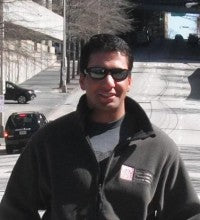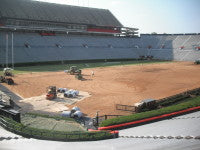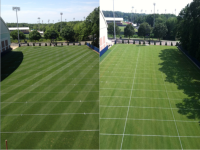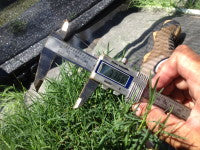Bridging the sportsfield and the lab
 To choose what to do whilst completing your turf education is not an easy task. Apply for jobs, internships, exchange emails, sending CVs out, interviewing and all of that might take a few hours of your sleep. However, I want to take a step back and refer to the education process.
To choose what to do whilst completing your turf education is not an easy task. Apply for jobs, internships, exchange emails, sending CVs out, interviewing and all of that might take a few hours of your sleep. However, I want to take a step back and refer to the education process.
Agriculture, agronomy, horticulture, landscaping or, specifically, turfgrass management are some of the courses that prepare us for this career. After a few years going to school, taking classes, completing assignments and exams, we have a better chance to succeed in this area of work.
The role played by the universities and colleges goes beyond that. They generate information through research. Turf cultivar tests, fertiliser rates, herbicides symptomology and activity, or even turf physiological responses to stresses, are some of the tasks that turf professors in college are responsible for, besides teaching. In fact, some of them don't even teach, due to a 100% research appointment.
So, with that said, we may arrive at our first issue: if information and guidelines for maintaining a sportsfield come from the universities, from people that don't manage them, with 100% teaching/research appointments, how to make sure that this information translates to the turf manager?
Well, here at Auburn University, in the state of Alabama, this is a major concern. We know that this gap between research and management can get big enough to create a "black hole" in turfgrass extension, and we found a particularly interesting way to approach this.
 I'm a graduate research assistant (aka full time graduate student), working on my PhD degree in a research project that focuses on bermuda grass sports fields: cultivar testing, shade tolerance, wear tolerance and rootzone construction are some of the issues I'm working on.
I'm a graduate research assistant (aka full time graduate student), working on my PhD degree in a research project that focuses on bermuda grass sports fields: cultivar testing, shade tolerance, wear tolerance and rootzone construction are some of the issues I'm working on.
However, I have a very practical background, having attended The Ohio State University International Turfgrass Program and worked for golf courses all over the USA. When I decided to continue my education at Auburn University, I found it very ironic that the project I'm working on is partially funded by the university's Athletics Department, in collaboration with the Department of Agronomy and Soils, which makes me not only a graduate student, but also a member of the turfgrass crew at Auburn.
On the research side, besides classes, field and laboratory work, there's a lot of reading and writing the dissertation and scientific publications, things that will accredit me to accomplish the degree.
 On the management side, it's our responsibility to take care of all the University's fields, and we have eight of them to keep up with: one football field at Jordan-Hare Stadium, three practice fields (including one indoor field) at the practice facility, one baseball field at the Plainsman Park, one softball field, and two fields in the Soccer/Track complex.
On the management side, it's our responsibility to take care of all the University's fields, and we have eight of them to keep up with: one football field at Jordan-Hare Stadium, three practice fields (including one indoor field) at the practice facility, one baseball field at the Plainsman Park, one softball field, and two fields in the Soccer/Track complex.
The management of that many and different types of field brings unique challenges year-round. With different sports being played at different times of the year (and with overlapping seasons), it's important to change our management standards from field to field.
For instance, the American football season is a big deal here in the southeastern USA. The season only lasts from September to December, with around eight games being played on our field. However, overseeding the field in the middle of the season with perennial ryegrass, due to bermuda grass winter dormancy and the amount of wear imposed to the field every game, can have a huge impact on playability and safety.
On top of that, the field has to be playable and looking beautiful year-round for practice sessions and scrimmages. The football practice fields suffer more from usage than the stadium; with practice routines almost everyday, we may face the situation where each field is hosting the equivalent to four games a week. This is a lot of traffic to handle.
 With baseball, the challenge is different. The season lasts from late winter to early summer, with around thirty-five games played at home, and a high school tournament played on the field after the season is over, accounting for ninety-five games in one month. Also, the baseball season is entirely played on a bermuda grass field overseeded with perennial ryegrass, which gets complicated to manage as we approach the higher temperatures close to summertime.
With baseball, the challenge is different. The season lasts from late winter to early summer, with around thirty-five games played at home, and a high school tournament played on the field after the season is over, accounting for ninety-five games in one month. Also, the baseball season is entirely played on a bermuda grass field overseeded with perennial ryegrass, which gets complicated to manage as we approach the higher temperatures close to summertime.
The goal now is to keep the field playing consistently all season long, especially the well worn areas and, as far as turfgrass wear is concerned, the grassed infield and the outfielders spots are what suffer the most.
After that comes the real challenge, a late transition from perennial ryegrass to bermuda grass to get the field healthy and in shape for practices and the next season. Now, you can imagine all challenges we have for each sport. Women's soccer season, track and field meetings and tournaments require a big "tool box" from the managers and the crew to provide safe, playable and aesthetically pleasant fields year-round.
 On the research side of it, we try to meet the manager's needs. Bermuda grass is the turfgrass of choice for athletic fields in this area of the country, and its two major management issues are wear tolerance (due to overuse of a field), and shade tolerance.
On the research side of it, we try to meet the manager's needs. Bermuda grass is the turfgrass of choice for athletic fields in this area of the country, and its two major management issues are wear tolerance (due to overuse of a field), and shade tolerance.
The overuse of the field can be solved by not allowing games for a period of time, allowing a larger recovery period for the field. Well, thinking about games played: how much is too much?
We are investigating in our research five bermuda grass cultivars: Tifway and TifSport (the industry standards), Patriot, Celebration and the newest shade tolerant cultivar, TifGrand, submitted to a different number of games over a period of time: 0, 1, 3 and 5 NFL games per week, simulated with a Cady Traffic Simulator.
With this research, we want to approach from the professional and collegiate standpoint (one game/week), to the practice and recreational standpoint - with three and five games played per week. We're now evaluating the results from the first year's experimental run, but it all indicates that wear influences turfgrass cover, soil compaction (especially in the first 2.5cm of the soil profile) and playability (surface hardness and traction).
 The other major downside of bermuda grass that we are also investigating is its shade tolerance. Warm season grasses, and especially bermuda grass, have a higher light compensation point than cool season grasses and, therefore, they are less tolerant to shaded or low light environments. The light compensation point is when plant photosynthesis equals respiration and, therefore, there's no energy left or stored for plant growth. This has become problem number one for bermuda grass sports fields, as the stadiums nowadays are built taller, more erect and roofed. Our approach is to investigate light intensity and light quality (the light spectrum) separately. This plays a major role in how much light the plants can harvest to photosynthesise.
The other major downside of bermuda grass that we are also investigating is its shade tolerance. Warm season grasses, and especially bermuda grass, have a higher light compensation point than cool season grasses and, therefore, they are less tolerant to shaded or low light environments. The light compensation point is when plant photosynthesis equals respiration and, therefore, there's no energy left or stored for plant growth. This has become problem number one for bermuda grass sports fields, as the stadiums nowadays are built taller, more erect and roofed. Our approach is to investigate light intensity and light quality (the light spectrum) separately. This plays a major role in how much light the plants can harvest to photosynthesise.
Light conditions, together with wear, will ultimately determine the field recovery potential. After a determined number of events that will wear the grass out to a point, we need to know how fast that grass will recover under those specific environmental conditions (i.e. within a stadium), so we can work on our game and maintenance schedules to provide a playable and safe field as soon as possible for the next event.
I'm an Agronomist Engineer, a native of Brazil, specialised in turfgrass management. As bermuda grass is also the turfgrass of choice for tropical and subtropical areas all around the world, and with the expansion of the sports biggest events to developing countries and growing economies, this type of experience and research can help these growing turf industries to set higher standards, providing world class sportsfields at any given time.

